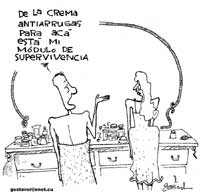Sexo Sentido
A new kind of male
? (III)
A CubaNews translation. Edited by Walter Lippmann. Original:
http://www.juventudrebelde.cu/secciones/sexosentido/2004/abril/abril17/PATRON_SEXO.html
Publicity fosters narcissism. Is the “metrosexual” man a living example?
 CAPTION:
“The anti-wrinkle cream to the
CAPTION:
“The anti-wrinkle cream to the
left of the table is my survival kit”
The metrosexuals, a new “kind of man” for whom physical appearance is much more important than any other aspect of their personal identity, are starting to make their way in consumer societies.
A result of the cultural changes we’ve seen in the last few decades, these “characters” have become the “target” of publicity campaigns mostly focused on male fashion and beauty products.
According to specialists, a metrosexual is a man between the ages of 25 and 40, obsessed with his body, watches his weight, and cares for his complexion. Among other requirements, they must be slim-waisted, manicured and have enough money to be able to project an ‘impeccable’ image at all times.
They are described as men who love to go shopping more than anything else and whose clothes must be well-coordinated with their partner’s. They are tender, passionate, quite enthusiastic about home decoration and capable of voicing their emotions without any prejudice.
That’s how they have been designed by overpowering and selfish advertising campaigns more interested in turning some men into victims of a business worth millions than they are in fostering a person’s positive values.
A lifestyle very similar to women’s is a regular feature of this new kind of man who favors a balanced diet, wears creams and cosmetics and shaves his body as much as the latter do.
As indicated by the New York-based Euro RSCG Worldwide agency in statements making the rounds of the Internet today, these men cannot be called gay. “They’re heterosexuals conversant with and mindful of fashion, food and beauty products, and quite open about it”.
Not a new term
Common sense to the contrary, this lifestyle is linked to neither men’s sexual preferences nor the size of their genitals. “Metro” responds to the fact that they usually live in or within easy reach of a big city, and “sexual” is said to come from the fact that they are female-friendly.
And it’s not a new term. It has just made a sound comeback, ten years after it was first used by British writer Mark Simpson in a 1994 article against the effects of consumerism on male identity, and then the media took care of turning into an instrument what Simpson claims to have meant as “cheeky satire”.
Many scholars label the behavior an offshoot of the “American model”, based on men with an allegedly successful life and a wish to stand out among others, a modern-day, practical male capable of seducing any woman who takes himself as his own love object.
This phenomenon gives rise to a self-centered human being, much more interested in his image and, it seems, extremely “sure” and “conscious” of his sexuality.
I believe that the proliferation of metrosexuals is somehow conditional on the way gender conceptions have changed ever since the struggle began last century to make it possible for males and females to live together without too much trouble.
The trend stems perhaps from efforts to make men more sensitive, delicate and keen on housework without detriment to their manliness and let women take on roles historically assigned to the former.
A harmful narcissism
We may wonder then whether this kind of narcissism could ever be harmful. Experts say that as long as they won’t exclude the opposite sex and care for something more than just their pleasure, there’s no reason for it to become an unhealthy addiction.
But if a man searching for perfection and the glorification of his female side ends up rejecting the outside world, his lifestyle of choice will no doubt bring him suffering and inability to operate as a social subject.
It’s still too soon to make predictions, but what’s certain is that there’s reason to worry about how much this phenomenon has increased as a consequence of the nonstop aggression waged by the advertising agencies, many of which have launched a wide range of products for this new kind of man under pretext that males need and have the right to boost their ego and show off so as to like themselves and be liked.
In their frenzy, they try to sell this image by encouraging men to be obsessively self-conscious, discover their female self and be concerned about their appearance.
Is this a threat to masculinity? Are the metrosexuals really human beings with a well-defined sexual identity?
The blame for men’s choice of this market offer does not lie entirely with the advertising agencies, regardless of their flair for manipulation. Only those subjective enough to fulfill the requirements of a metrosexual will get hooked on these products. Accordingly, the traditional male image is not in danger of extinction.
---ooOoo---
http://www.juventudrebelde.cu/secciones/sexosentido/2004/abril/abril17/PATRON_SEXO.html
|
http://www.juventudrebelde.cu/secciones/sexosentido/2004/abril/abril17/PATRON_SEXO.html



